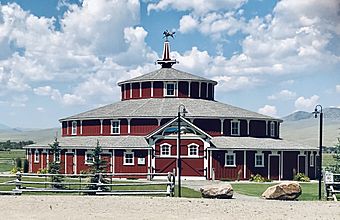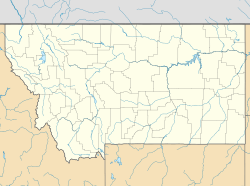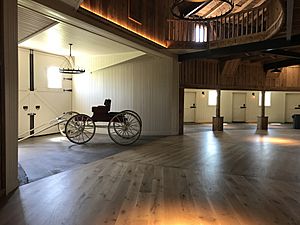Doncaster Round Barn facts for kids
Quick facts for kids |
|
|
Doncaster Round Barn
|
|

Doncaster Round Barn
|
|
| Location | near Twin Bridges, Montana, United States |
|---|---|
| Built | c. 1882 |
| Architectural style | Round, wood-frame barn |
| NRHP reference No. | 15000150 |
| Added to NRHP | April 14, 2015 |
The Doncaster Round Barn is a special three-story barn made of wood. It's also known as "Bayers' Barn" or "the Round Barn at Twin Bridges." You can find it about 1.5 miles north of Twin Bridges, Montana.
This unique barn was built around 1882. A rich mining businessman named Noah Armstrong had it built for his racehorses. It even has a 20-foot-wide indoor circular path where horses could exercise! The barn is famous for its unusual design. It's also known as the birthplace of Spokane, a Thoroughbred racehorse who won the 1889 Kentucky Derby. Because of its history and design, the Doncaster Round Barn is now listed on the National Register of Historic Places.
Building a Horse Haven
Noah Armstrong became wealthy from mining. He loved horses and even organized races in his mining camp. After leaving the mining business, he bought a large piece of land near Twin Bridges. He wanted to raise racehorses there.
Armstrong bought more land until he owned 4,000 acres! He named his property Doncaster Farm. This name honored a famous English racehorse named Doncaster that Armstrong admired. Before that, the property was called the Jefferson River Ranch.
Amazing Design of the Barn
The Doncaster Round Barn was built in 1882. Noah Armstrong designed it himself. Local builders likely used materials from the area to construct it.
The barn is 48 feet tall. It looks a bit like a "wedding cake," with each floor smaller than the one below it.
- The first floor is about 100 feet wide.
- The second floor is about 75 feet wide.
- The third floor is about 30 feet wide.
The barn's foundation was made from stones. These stones came from a canyon about 5 miles away. Armstrong said the foundation went 12 feet deep! The walls were made of wooden planks. They had three layers of wood with special paper in between for insulation. Above the main entrance, there was once a carved scene of horses.
The ground floor of the barn had a 20-foot-wide indoor training track. It had a dirt surface and was almost a quarter-mile around. Armstrong's horses used this track for exercise. If the weather was bad, horses usually kept outside could stay warm and dry here.
Around the track, there were 26 box stalls for horses. The walls between the stalls were only four feet high. Armstrong believed this helped the horses feel less lonely. Each stall had a door leading outside to its own small fenced area, called a paddock. There were 26 paddocks in total, covering 2.5 acres.
In the center of the barn, there was a circular area. This area held the tack room (where horse equipment is stored) and two special stalls for sick horses. A spiral staircase led to the upper floors. There was also a lift to move hay and grain. A well was dug in the center of the barn. Water from the well was pumped by a windmill on top of the barn. This water was stored in a huge 11,000-gallon tank on the third floor. From there, water flowed by gravity to each horse's stall. The first floor also had offices and sleeping areas for the staff.
The second floor was very large. It could hold up to 50 tons of hay and 12,000 bushels of grain! The floor was sloped, and chutes were cut into it. This made it easy to drop food right into the horses' mangers (feeding troughs) below.
Noah Armstrong's son, Charles, once said the barn was "a model of architectural beauty and convenience." He thought it was very clever and perfect for its purpose.
Barn's Story: Horses, Cattle, and Renovation
Noah Armstrong believed that Montana's high altitude and rich farmland were perfect for raising strong racehorses. His horses raced at big tracks across the United States. One of his horses, Lord Raglan, even finished third in the 1883 Kentucky Derby.
In 1885 or 1886, Armstrong brought a pregnant mare named Interpose to Montana. Her foal, Spokane, was born in the Doncaster Round Barn in 1886. Spokane, a chestnut racehorse, started his training on the barn's indoor track. At age two, he was sent east for more training. Spokane then won the Kentucky Derby in 1889! He also won other important races. While some stories say he returned to Montana, there's no proof of that. He was advertised as a breeding horse in Kentucky.
A financial crisis in 1893 made things difficult for Armstrong's farm. He sold the ranch to Max Lauterbach and left Montana in 1900. After that, the barn had many different owners and started to fall apart.
The Bayers family bought the Doncaster Farm property in 1933. They owned it until 1997. Arthur and Elizabeth Bayers raised Hereford cattle and were very successful breeders. They sold their cattle all over North America and held a big cattle sale in the barn every year. Their son, Byron Bayers, said their cattle sales brought in over $5 million! Keeping the barn in good shape was very expensive, especially buying red paint for it.
The Bayers family sold the part of the land with the barn in 1985. The barn again started to fall into disrepair. In 1997, a real estate developer named Allan Hamilton bought it. He started to fix it up, putting on a new roof and leveling the foundation.
In 2010, Tony and Amie James bought the property. They wanted to turn the barn into a community center. Even though everyone thought the barn was already on the National Register of Historic Places, it wasn't! In January 2015, the Montana Historic Preservation Board agreed to nominate it. The Doncaster Round Barn was officially added to the National Register of Historic Places on April 14, 2015.
The building also received a Montana Cowboy Hall of Fame Legacy Award in 2008. The Jameses even offered to donate the barn to house the Montana Cowboy Hall of Fame, but a different location was chosen.






